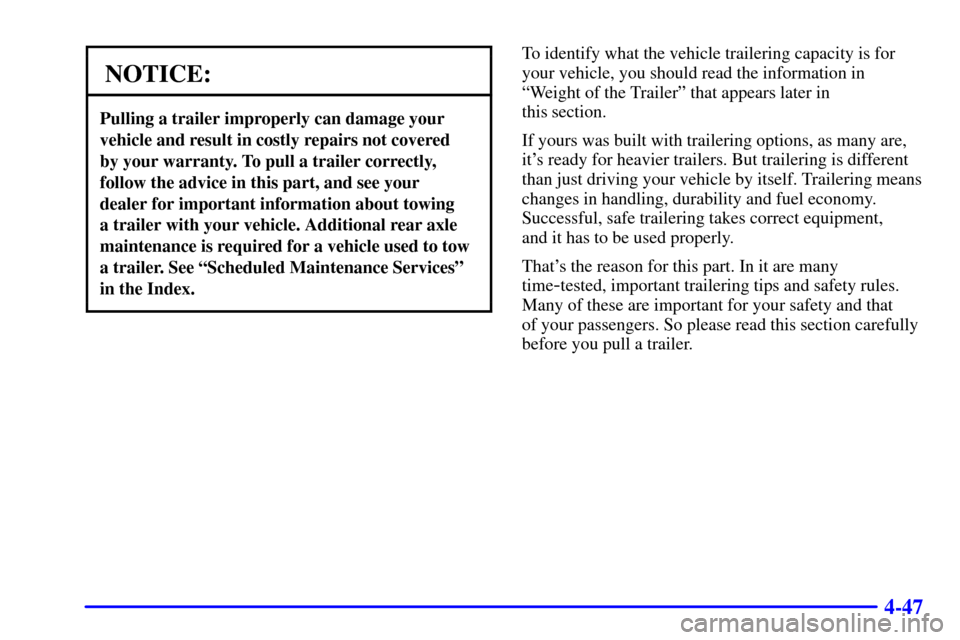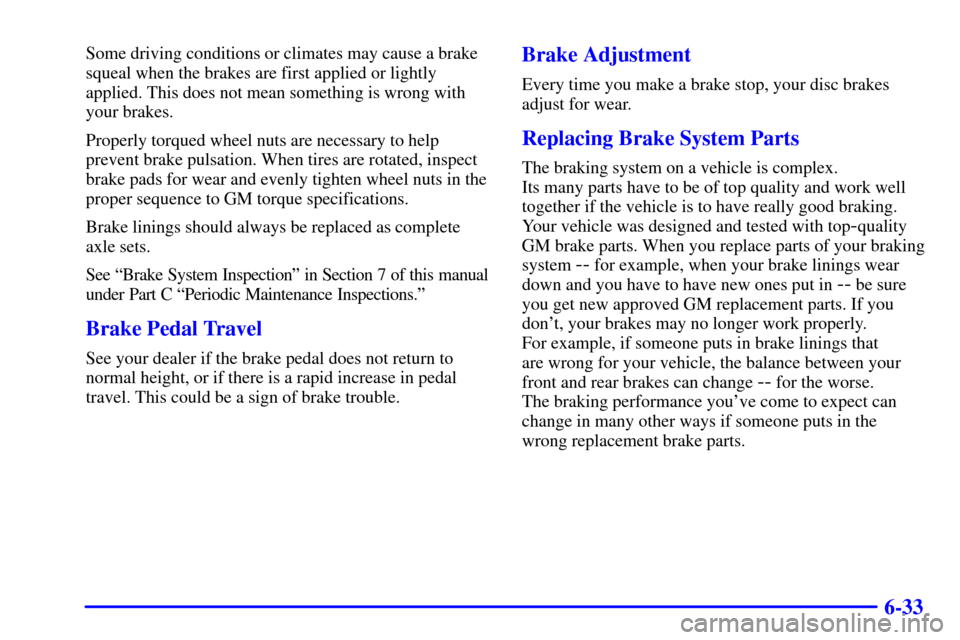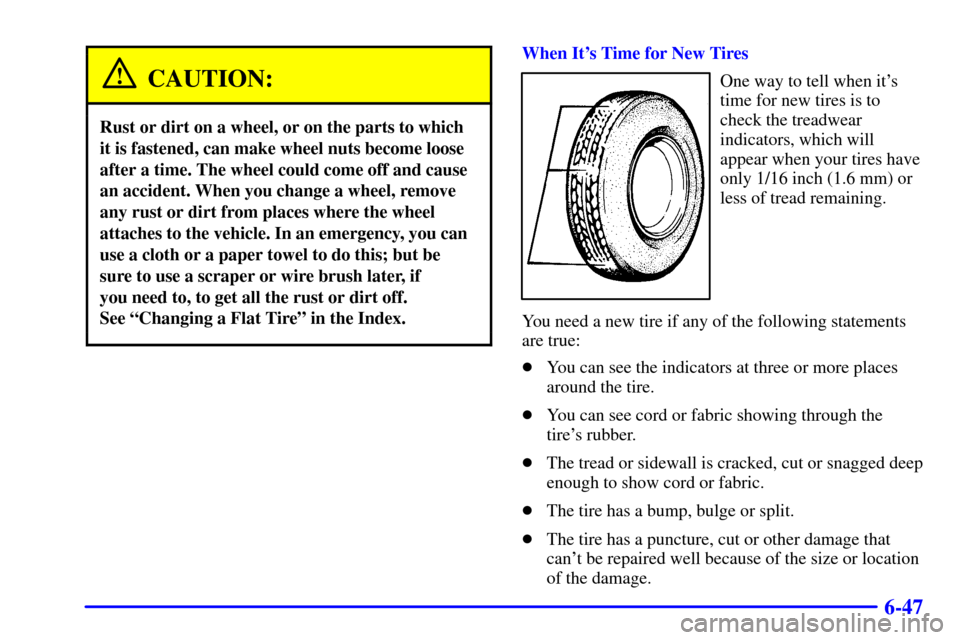Page 263 of 448

4-47
NOTICE:
Pulling a trailer improperly can damage your
vehicle and result in costly repairs not covered
by your warranty. To pull a trailer correctly,
follow the advice in this part, and see your
dealer for important information about towing
a trailer with your vehicle. Additional rear axle
maintenance is required for a vehicle used to tow
a trailer. See ªScheduled Maintenance Servicesº
in the Index.
To identify what the vehicle trailering capacity is for
your vehicle, you should read the information in
ªWeight of the Trailerº that appears later in
this section.
If yours was built with trailering options, as many are,
it's ready for heavier trailers. But trailering is different
than just driving your vehicle by itself. Trailering means
changes in handling, durability and fuel economy.
Successful, safe trailering takes correct equipment,
and it has to be used properly.
That's the reason for this part. In it are many
time
-tested, important trailering tips and safety rules.
Many of these are important for your safety and that
of your passengers. So please read this section carefully
before you pull a trailer.
Page 265 of 448

4-49
Tow/Haul Mode (V6 Engine, Automatic
Transmission Equipped Models) (If Equipped)
The tow/haul mode is a feature that assists when pulling
a heavy trailer. The purpose of the tow/haul mode is to
do the following:
�Reduce the frequency of shifts when pulling a
heavy trailer,
�provide the same shift feel when pulling a heavy
trailer as when the vehicle is unloaded, and
�reduce the need to change throttle position when
pulling a heavy trailer.
This feature is turned on or off by pressing a button
on the floor console or the shift knob. When the feature
is on, a light located on the instrument panel cluster
will illuminate to indicate that the tow/haul mode has
been selected.
See ªTow/haul Mode Lightº in the Index. The tow/haul
mode is automatically turned off each time the vehicle
is started.The tow/haul mode is most effective when the vehicle
and trailer combined weight is at least 75% of the Gross
Vehicle Weight Rating (GVWR) and the maximum
trailer weight rating for the vehicle. See ªGross Vehicle
Weight Ratingº and ªTrailer Weightº in the Index.
The tow/haul mode for hauling a heavy trailer is most
useful under the following conditions:
�When driving through hilly terrain at speeds
below 55 mph (88 km/h),
�when driving in low speed or stop and go traffic
below 55 mph (88 km/h), and
�when driving in parking lots.
Use the tow/haul mode instead of the previous
recommendation to shift to THIRD (3) gear to improve
fuel economy at highway speeds and shift performance
at lower speeds. Operating in the tow/haul mode when
not pulling a heavy trailer will not cause damage to the
vehicle, but you may experience reduced fuel economy
and undesirable performance from the engine and
transmission. The tow/haul mode should be used
only when pulling a heavy trailer.
Page 299 of 448
5-25
6. Remove any rust or dirt
from the wheel bolts,
mounting surfaces and
spare wheel.
CAUTION:
Rust or dirt on the wheel, or on the parts to
which it is fastened, can make the wheel nuts
become loose after a time. The wheel could come
off and cause an accident. When you change a
wheel, remove any rust or dirt from the places
where the wheel attaches to the vehicle. In an
emergency, you can use a cloth or a paper towel
to do this; but be sure to use a scraper or wire
brush later, if you need to, to get all the rust or
dirt off.
CAUTION:
Never use oil or grease on studs or nuts. If you
do, the nuts might come loose. Your wheel could
fall off, causing a serious accident.
7. Place the spare on the wheel mounting surface.
8. Put the nuts on by hand.
Make sure the rounded
end is toward the wheel.
Tighten each nut by hand until the wheel is held against
the hub. If a nut can't be turned by hand, use the wheel
wrench and see your dealer as soon as possible.
Page 324 of 448

6-17
Automatic Transmission Fluid
When to Check and Change
A good time to check your automatic transmission fluid
level is when the engine oil is changed.
Change both the fluid and filter every 15,000 miles
(25 000 km) if the vehicle is mainly driven under one or
more of these conditions:
�In heavy city traffic where the outside temperature
regularly reaches 90�F (32�C) or higher.
�In hilly or mountainous terrain.
�When doing frequent trailer towing.
�Uses such as found in taxi, police or delivery service.
If you do not use your vehicle under any of
these conditions, change the fluid and filter every
50,000 miles (83 000 km).
See ªScheduled Maintenance Servicesº in the Index.
How to Check
Because this operation can be a little difficult, you may
choose to have this done at the dealership service department.
If you do it yourself, be sure to follow all the instructions
here, or you could get a false reading on the dipstick.
NOTICE:
Too much or too little fluid can damage your
transmission. Too much can mean that some of
the fluid could come out and fall on hot engine
parts or exhaust system parts, starting a fire.
Be sure to get an accurate reading if you check
your transmission fluid.
Wait at least 30 minutes before checking the
transmission fluid level if you have been driving:
�When outside temperatures are above 90�F (32�C).
�At high speed for quite a while.
�In heavy traffic
-- especially in hot weather.
�While pulling a trailer.
Page 327 of 448

6-20
Manual Transmission Fluid
When to Check
A good time to have it checked is when the engine
oil is changed. However, the fluid in your manual
transmission doesn't require changing.
How to Check
Because this operation can be a little difficult, you may
choose to have this done at your GM dealership
service department.
If you do it yourself, be sure to follow all the
instructions here, or you could get a false reading.
NOTICE:
Too much or too little fluid can damage your
transmission. Too much can mean that some of
the fluid could come out and fall on hot engine
parts or exhaust system parts, starting a fire.
Be sure to get an accurate reading if you check
your transmission fluid.
Check the fluid level only when your engine is off, the
vehicle is parked on a level place and the transmission is cool
enough for you to rest your fingers on the transmission case.
Then, follow these steps:
1. Remove the filler plug.
2. Check that the lubricant level is up to the bottom of
the filler plug hole.
3. If the fluid level is good, install the plug and be sure
it is fully seated. If the fluid level is low, add more
fluid as described in the next steps.
Page 340 of 448

6-33
Some driving conditions or climates may cause a brake
squeal when the brakes are first applied or lightly
applied. This does not mean something is wrong with
your brakes.
Properly torqued wheel nuts are necessary to help
prevent brake pulsation. When tires are rotated, inspect
brake pads for wear and evenly tighten wheel nuts in the
proper sequence to GM torque specifications.
Brake linings should always be replaced as complete
axle sets.
See ªBrake System Inspectionº in Section 7 of this manual
under Part C ªPeriodic Maintenance Inspections.º
Brake Pedal Travel
See your dealer if the brake pedal does not return to
normal height, or if there is a rapid increase in pedal
travel. This could be a sign of brake trouble.
Brake Adjustment
Every time you make a brake stop, your disc brakes
adjust for wear.
Replacing Brake System Parts
The braking system on a vehicle is complex.
Its many parts have to be of top quality and work well
together if the vehicle is to have really good braking.
Your vehicle was designed and tested with top
-quality
GM brake parts. When you replace parts of your braking
system
-- for example, when your brake linings wear
down and you have to have new ones put in
-- be sure
you get new approved GM replacement parts. If you
don't, your brakes may no longer work properly.
For example, if someone puts in brake linings that
are wrong for your vehicle, the balance between your
front and rear brakes can change
-- for the worse.
The braking performance you've come to expect can
change in many other ways if someone puts in the
wrong replacement brake parts.
Page 354 of 448

6-47
CAUTION:
Rust or dirt on a wheel, or on the parts to which
it is fastened, can make wheel nuts become loose
after a time. The wheel could come off and cause
an accident. When you change a wheel, remove
any rust or dirt from places where the wheel
attaches to the vehicle. In an emergency, you can
use a cloth or a paper towel to do this; but be
sure to use a scraper or wire brush later, if
you need to, to get all the rust or dirt off.
See ªChanging a Flat Tireº in the Index.
When It's Time for New Tires
One way to tell when it's
time for new tires is to
check the treadwear
indicators, which will
appear when your tires have
only 1/16 inch (1.6 mm) or
less of tread remaining.
You need a new tire if any of the following statements
are true:
�You can see the indicators at three or more places
around the tire.
�You can see cord or fabric showing through the
tire's rubber.
�The tread or sidewall is cracked, cut or snagged deep
enough to show cord or fabric.
�The tire has a bump, bulge or split.
�The tire has a puncture, cut or other damage that
can't be repaired well because of the size or location
of the damage.
Page 380 of 448

6-73 Capacities
Please refer to ªRecommended Fluids and Lubricantsº
in the Index for more information.
Cooling System*
Automatic Trans. 11.7 quarts (11.1 L). . . . . . . . . . . .
Manual Trans. 11.9 quarts (11.3 L). . . . . . . . . . . . . .
Crankcase* 4.5 quarts (4.3 L). . . . . . . . . . . . . . . . .
Automatic Transmission
(Drain and Refill)* 5.0 quarts (4.7 L). . . . . . . . .
Differential Fluid
Rear 4.0 pints (1.9 L). . . . . . . . . . . . . . . . . . . . . . . .
Front 2.6 pints (1.2 L). . . . . . . . . . . . . . . . . . . . . . .
Fuel Tank
(2
-Door Models) 19.0 U.S. gallons (72.0 L). . . .
Fuel Tank
(4
-Door Models) 18.0 U.S. gallons (68.0 L). . . .
A/C Refrigerant See refrigerant charge label. . . . . .
under the hood.
*All capacities are approximate. After refill, the level
must be checked.
Normal Maintenance
Replacement Parts
Replacement part numbers listed in this section are
based on the latest information available at the time of
printing, and are subject to change. If a part listed in this
manual is not the same as the part used in your vehicle
when it was built, or if you have any questions, please
contact your GM dealer.
Thermostat** 12559051. . . . . . . . . . . . . . . . . . . . . . .
Oil Filter* (2
-Wheel Drive) PF47 (PF52 Optional). . .
Oil Filter* (4
-Wheel Drive) PF52. . . . . . . . . . . . . . . .
Air Cleaner Filter* A1163C. . . . . . . . . . . . . . . . . . . . .
PCV Valve* CV769C. . . . . . . . . . . . . . . . . . . . . . . . .
Automatic Transmission Filter Kit** 24200796. . . .
Spark Plugs* 41
-932 . . . . . . . . . . . . . . . . . . . . . . . . . .
Fuel Filter* GF481. . . . . . . . . . . . . . . . . . . . . . . . . . . .
Front Windshield
Wiper Blade Trico 20 inches (50.8 cm). . . . . . . . . .
Backglass Wiper Blade Trico 14 inches (35.6 cm). . .
*ACDelco
� Part No.
**GM Part No.